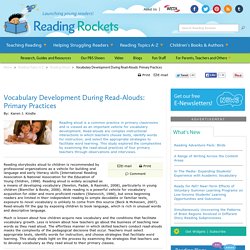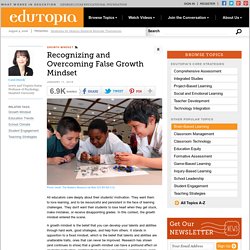

13 Strategies to Improve Student Classroom Discussions. Questions inspire!

When educators pose thought-provoking questions to their students, they send a powerful message that students’ ideas about what they read are valuable. Great Books' professional learning courses, webinars and consultation days help educators gain new instructional strategies, pose higher-order and text-dependent questions, and encourage classroom discussion. Asking the right questions at the right time is a skill best cultivated over time. Vocabulary Development During Read-Alouds: Primary Practices. Reading storybooks aloud to children is recommended by professional organizations as a vehicle for building oral language and early literacy skills (International Reading Association & National Association for the Education of Young Children, 1998).

Reading aloud is widely accepted as a means of developing vocabulary (Newton, Padak, & Rasinski, 2008), particularly in young children (Biemiller & Boote, 2006). Wide reading is a powerful vehicle for vocabulary acquisition for older and more proficient readers (Stanovich, 1986), but since beginning readers are limited in their independent reading to simple decodable or familiar texts, exposure to novel vocabulary is unlikely to come from this source (Beck & McKeown, 2007). Read-alouds fill the gap by exposing children to book language, which is rich in unusual words and descriptive language. Much is known about how children acquire new vocabulary and the conditions that facilitate vocabulary growth. Adult mediation in read-alouds. Booksource's Top Ten Titles to Inspire Creativity and Innovation! 25 Question Stems Framed Around Bloom's Taxonomy. 25 Question Stems Framed Around Bloom’s Taxonomy While critical thinking is a foundation rather than a brick, how you build that foundation depends on the learning process itself: exposing students to new thinking and promoting interaction with that thinking in a gradual release of responsibility approach.

Question stems can be a powerful part of that process no matter where the learner is. Give Kids Their Reading Choice. "There are no reluctant readers," proclaims Lisa Von Drasek, the effervescent children's librarian at Bank Street College of Education in New York, "just kids who haven't found their choice yet.

" Plug into her way of thinking, and you'll see your child's relationship to reading in a whole new light. She suggests these strategies for your not-yet-passionate reader: Don't pressure him to read a certain something. Let him choose what he's going to read. Some kids will devour a World War II book, while others want The Sporting News or a teen magazine. Great books that inspire a love of reading in kids — recommended by kids. In this Dec. 1, 2014 photo, from left, Edgewood Elementary School kindergartners Asha Wilson, Jacob Grimm and Hunter Potter look over the “Acoustic Rooster and his Barnyard Band,” book in Fruitport, Mich.

The 8 Minutes That Matter Most. I am an English teacher, so my ears perk up when writers talk about their process.

I've found the advice handy for lesson planning, too. That's because both writing and planning deal with craft. In writing, you want your audience to be absorbed. You want them to care about your characters. You want them be delighted by the suspense. John Irving, the author of The Cider House Rules, begins with his last sentence: I write the last line, and then I write the line before that. That is the crux of lesson planning right there -- endings and beginnings.
The eight minutes that matter most are the beginning and endings. Here are eight ways to make those eight minutes magical. Beginnings. 5 Reasons to Use Mentor Texts With Big Kids - The Teacher Next Door - Creative Ideas From My Classroom To Yours. When I changed grade levels from second grade to 4th/5th, one of the things I really thought I would miss was all of my wonderful picture books.

I used to love to read and re-read them to the kids, to gaze at their delightful pictures, and to use them to get kids excited about the magic of reading. Over the years, I loved picture books so much that if you saw my collection, you might have wanted to nominate me for some kind of teaching hoarder show (I had that many)! When we moved across the country and my new teaching job was 4th/5th (scared the dickens out of me at that time), I thought I would have to give up my picture books, pack them into boxes, and store them in my garage.
But once I realized how effective they could be with my big kids, I happily unwrapped these picture book treasures and carted them off to school. Now, many of my picture books are key mentor texts...the stars of countless mini-lessons. 1. 2. I love the fact that mentor texts are short and sweet. 10 Websites That Teachers Love Right Now! While visiting classrooms every day, I see teachers utilizing a great deal of technology.

Our district is currently in the early stages of a 1:1 Chromebook implementation, and also installed interactive projectors in all of our classrooms. Teachers have been utilizing the new technology to engage students using many different websites and resources. Below is a list of the 10 most popular websites that our teachers love right now! You may want to use these same websites in your own classroom. Geoguessr lets students journey and explore throughout the world. 22 Powerful Closure Activities. Too many university supervisors and administrators criticize the absence of lesson closure, a dubious assessment practice likely caused by the improper use of Madeline Hunter’s lesson plan model (PDF) as a de facto checklist of eight mandatory teaching practices -- anticipatory set, objective and purpose, input, modeling, checking for understanding, guided practice, independent practice, and closure -- a custom that Hunter decried in 1985 (PDF).

Although it offers multiple benefits, please don't view closure as a professional must-do. What Is Closure? Recognizing and Overcoming False Growth Mindset. All educators care deeply about their students' motivation.

They want them to love learning, and to be resourceful and persistent in the face of learning challenges. They don't want their students to lose heart when they get stuck, make mistakes, or receive disappointing grades. In this context, the growth mindset entered the scene. Recognizing and Overcoming False Growth Mindset. Cultivating a Classroom Culture of Creativity. A Guest Blog Post by Jeanne Muzi Cultivating a Classroom Culture of Creativity is a mindset and a skill set. You must believe in the power of incorporating creative problem solving and thinking activities into all the subject areas and be ready to take advantage of the “pockets” of time that develop during “normal” school days…when you have 5 minutes at the end of a lesson, two minutes during a transition, the 10 minutes you gain when an assembly finishes early, etc.
By using every opportunity to intentionally cultivate creativity, students can learn, practice and enhance their creative thinking skills! Creativity tends to grow in learning environments where students are taught to take intellectual risks. They have opportunities to learn and practice what it means to be open to new ideas and perspectives. Three things everyone can intentionally focus on right now in any classroom (you’re probably doing these things already) are: Higher Order Questioning: By Jeanne Muzi (@MuziLearningLab)
Prompts for speaking and writing. Writing Competitions. Writing Prompts. Write Now! Resources.